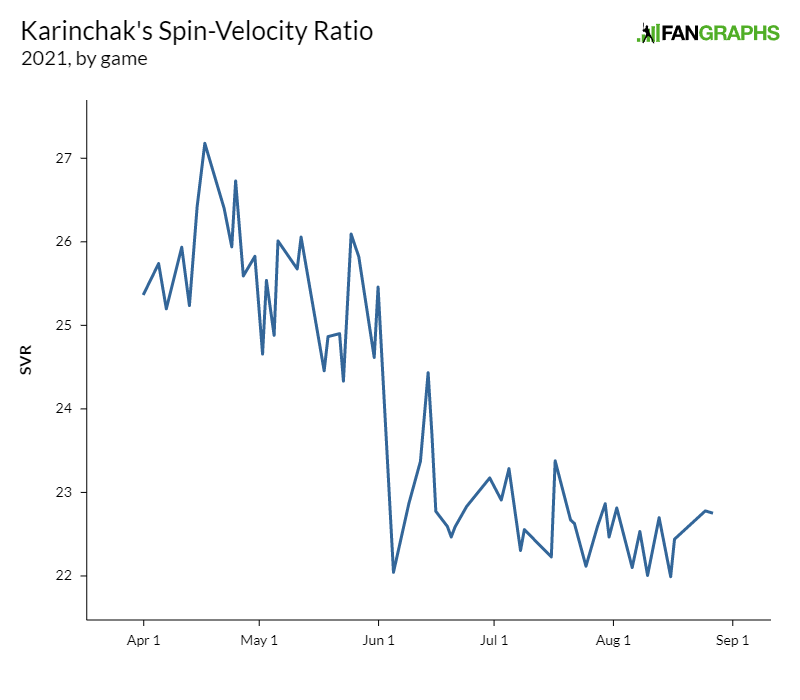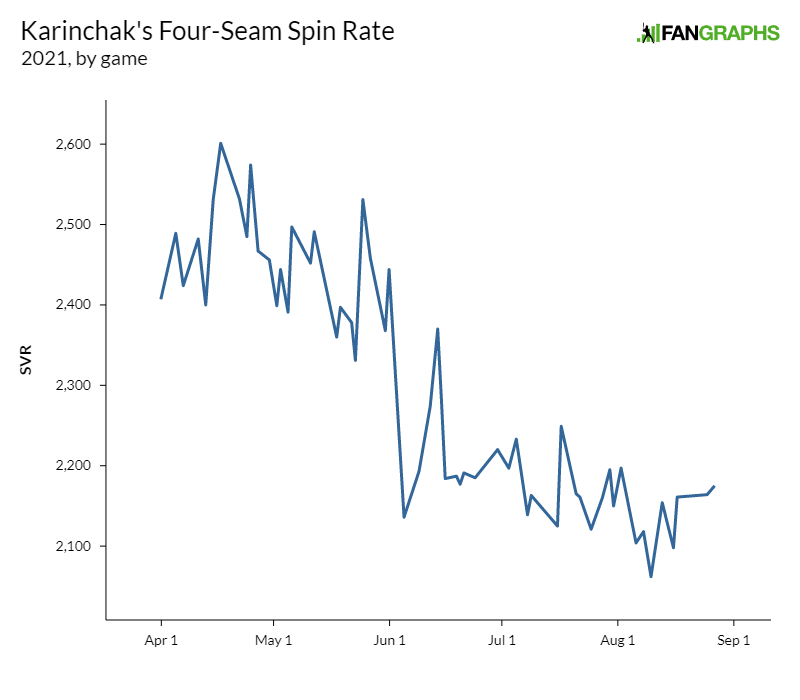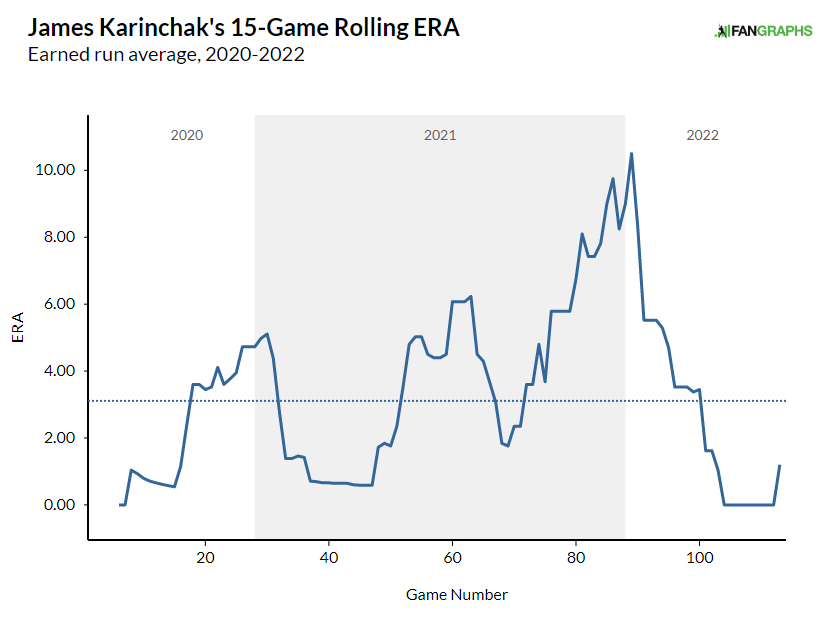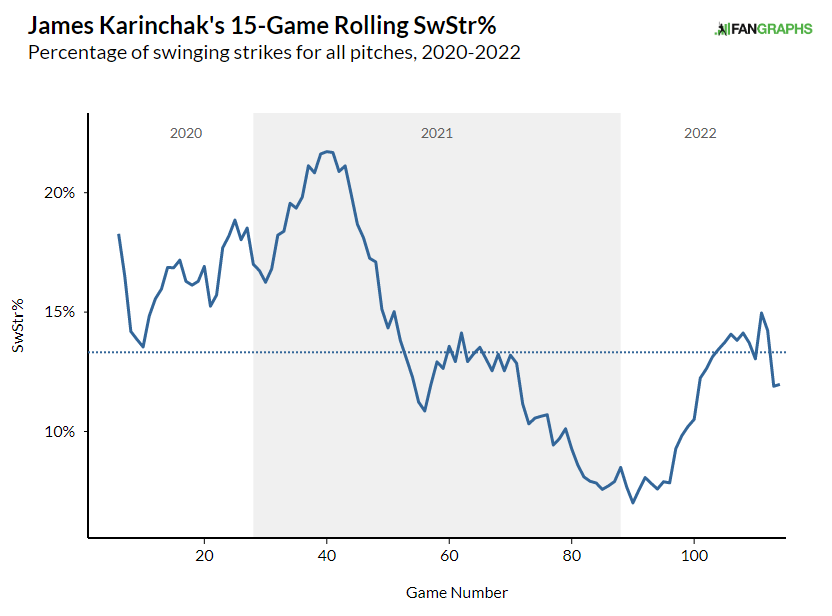Spinvestigation: Luscious Locks Edition

Friday night, umpire Ted Barrett got up close and personal with James Karinchak:
No, Barrett wasn’t looking for hair care tips, or acting out an Herbal Essences commercial. He was checking for foreign substances at the behest of Twins manager Rocco Baldelli. Though he ruffled around to the best of his ability, Barrett didn’t find anything definitive. Karinchak made it back to the dugout with a narrow lead and his pitching eligibility intact, though his dignity may have been affected.
Baldelli’s accusation wasn’t some off-the-cuff act of pettiness. Karinchak has been at the sticky center of controversy ever since the league cracked down on pine tar, Spider Tack, sunscreen/rosin blends, and whatever other tacky options players were using to increase spin. Stricter enforcement of existing rules started at the beginning of June last year; take a look at Karinchak’s spin-velocity ratio and raw fastball spin rate and you can clearly see when things changed:


Not coincidentally, Karinchak’s results slipped at the same time. He’d been an unhittable, fire-breathing, back-of-the-bullpen monster since reaching the majors. From June 1, 2021 onwards, however, he posted a 5.40 ERA and a 5.41 FIP, and got demoted to the minors at the end of August. The fall from grace was swift, and seemed obviously related to the change in foreign substance enforcement.
Here’s one thing you could say: Karinchak is clearly a talented pitcher. Maybe he just needed a little time to figure out how to throw the ball without a goop-enabled spin boost. Karinchak’s arsenal, after all, isn’t impressive solely because of its spin rate. His unique delivery and extreme over-the-top release point are both assets. Karinchak’s curveball generally breaks towards right-handed hitters, one of the only such pitches in baseball. His fastball is nearly all vertical movement, which is an enviable trait even without enhanced spin.
Indeed, he’s been steadily improving. After that disastrous end to the 2021 season and an IL stint to begin this season, Karinchak returned to the majors at the start of July, and after two shaky appearances, he put together a 23-appearance scoreless streak, only interrupted by the Twins and their dastardly hair-accusing manager:

Know what else has been improving? Karinchak’s spin-velocity ratio. As Rob Arthur detailed at Baseball Prospectus, pitchers are adding a frankly impossible amount of spin across the league this year. Maybe they’ve suddenly learned heretofore unknown techniques that boost spin using only finger pressure and sheer grit, but, uh, I wouldn’t bet on that.
How can you beat an umpire inspection? There are a lot of places on a baseball field to put something sticky, and they aren’t all the pitcher’s belt or hand. An infielder could surreptitiously dab something onto the ball when it goes around the horn. A catcher could have a reservoir of syrup hidden somewhere; who could forget Yadier Molina’s chest protector shenanigans? Or – hear me out – a pitcher could put something in his hair.
Karinchak plays with his hair a lot. As best as I can tell, he touches it before every single pitch he throws. If it’s like normal hair, that doesn’t sound great for his grip. Hair tends to get oily and sweaty, particularly when you’re working hard, which Karinchak absolutely is. What Baldelli was asking about wasn’t out of left field, though after the game, Guardians manager Terry Francona took exception with the inspection’s timing; you could hardly watch Karinchak in recent weeks without noticing how frequently he runs his fingers through his hair. Here’s a compilation of Karinchak touching his hair during Luis Arraez’s at-bat, which led to the inspection:
Whether he’s actually dousing a particular lock in Spider Tack or just self-tousling for good luck, Karinchak’s routine has paid spin dividends. Here’s that spin-velocity ratio, for a rolling 50 four-seam fastballs, over Karinchak’s major league career:

He’s nearly back to where he was pre-crackdown, perhaps 50-100 rpm lower for similar-velocity pitches. Some of that was probably just a matter of adjustment; every pitcher in baseball had to learn how to throw differently, and getting used to a differently-tacky baseball in real time no doubt has a learning curve. Some of it is harder to explain without assuming some foreign substance is involved. Regardless of how he’s added that spin, though, the results have been impressive. His swinging strike rate hasn’t quite rebounded to its highest level, but he’s been well above average there, despite a recent blip:

Swinging strikes are the name of the game with Karinchak. His fastball isn’t the hardest in baseball, but it’s one of the best at missing bats thanks to its unique shape. It falls less than 10 inches from its initial trajectory on its path to the plate; the average fastball thrown with his velocity and extension falls more like 13. Those extra three inches of ride produce a lot of swings like this:
His curveball is a curiosity thanks to his release point, but this year it’s been more of a supporting act than a headliner. As you might imagine, he has intermittent trouble locating it – it’s really hard to throw a breaking pitch (or any pitch, really) from that high slot. Hitters have an easy plan against it: just try not to swing. Only a quarter of his curves have drawn swings this year. That makes it less reliable as an out pitch – he’s frequently using his fastball in that role – but does mean that he racks up some called strikes when he’s spotting it.
If you’re wondering how much spin, and therefore movement, matters for pitchers, Karinchak is an extreme but instructive example. When you’re throwing a fastball whose one trick is carrying above opposing bats, losing some of that carry stings. Less spin means less carry quite directly, as you can see by splitting up Karinchak’s 2021 season into two parts:
| Pitch | Pre SVR | Post SVR | Pre VMov (in) | Post VMov (in) | Pre Whiff% | Post Whiff% |
|---|---|---|---|---|---|---|
| Fastball | 25.6 | 22.9 | 20.0 | 15.7 | 36.1% | 21.5% |
| Curveball | 28.7 | 26.8 | -9.0 | -8.4 | 40.5% | 40.8% |
I’m not completely surprised that his curveball, while also losing spin, didn’t change much when it comes to missing bats. That’s for two reasons. First, thanks to his grip, only roughly half of the spin he imparts on the ball contributes to its downward movement, so there’s less change in movement, which you can clearly see above. Second, the whiffs he generates with the curveball mostly aren’t ones that the batter just missed. Batters swing at pitches in the dirt, or complete their swing before the ball gets home, or just generally flail away. It’s a big-miss pitch while the fastball is a small-miss pitch, where every millimeter of movement is crucial.
I’m not sure Karinchak will ever get back to his peak form. He struck out 48.6% of the batters he faced in 2020, and 46.2% in the first two months of 2021. That number fell all the way to 24.6% late last year, but he’s back up near 40% this year. The best times rarely last, but Karinchak has done a decent peak-Spider-Tack impression in the new enforcement regime.
However he’s doing it, Karinchak is providing key innings for a Guardians team that needs every last bit of bullpen juice. The American League Central race is tight, and it would be tighter if it weren’t for Emmanuel Clase and the group behind him; the bullpen’s 3.18 ERA is the fourth-best in baseball, and they’re also fourth-best in win probability added. They’ve added roughly five more wins via their play than the White Sox and Twins bullpens – pretty great when the standings are separated by less than five games.
I’m curious to see what the future of foreign substance enforcement looks like. As the Arthur article made clear, pitchers are adapting to the new rules not by learning to pitch with less raw spin but by finding a way to add that spin back. Maybe it’s just a part of baseball now; it’s hard to put the genie back in the bottle, and pitchers used to an extra inch of movement will go to great lengths to rediscover it.
I’m also curious about the future of James Karinchak. He’s an outlier even among major league relievers; more movement, less idea where the ball is going, more animated on the mound. When he’s going well, it’s a fun show to watch. Heck, when he’s going poorly it’s fun too, though obviously in a different way. There have been more good times than bad of late, which means the odds are good that we’ll see this particular high-wire act on the playoff stage soon — and it might even involve a scalp massage.
Ben is a writer at FanGraphs. He can be found on Bluesky @benclemens.

The answer seems to be pretty simple. Sweat and rosin together are very sticky. Hair can get pretty sweaty and while it would be slippery by itself, it “activates” the rosin. If you look in the video (and in general), after going to his hair, he goes right to the rosin bag.
I think I remember seeing some research when the stricter enforcement was first announced that sweat + rosin adds only a tiny fraction of the spin that Karinchak has managed to find again this season. I could be misremembering, but if it really was that simple then I would think literally every pitcher would be doing the same thing…
I can’t say it with 100% certainty because I’m not an expert on the sticky science but it seems to be the most likely explanation for a couple of reasons. 1) That’s what Karinchak said it was after the game (Not the best source but should count for something 2) The umpire didn’t find anything obvious in his hair 3) Like I said, the next part of his ritual is to go right to the rosin bag on almost every pitch. In terms of why every pitcher isn’t doing the same thing, I think it’s possible that they are learning legal ways to get grip on the ball (like sweat and rosin) which is why the spin has gone up from post-enforcement last year where pitchers went cold turkey. The fact that it’s had a big effect on Karinchak might be because he goes to the rosin bag on basically every single pitch, which I haven’t seen from any pitcher I can remember, and that has to make some difference.
Hair gel hasn’t been banned and it’s very sticky. If you use it correctly, it just looks like hat head when you take your cap off.